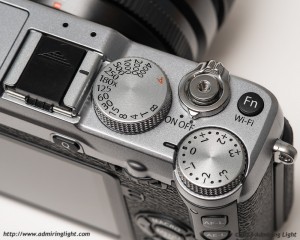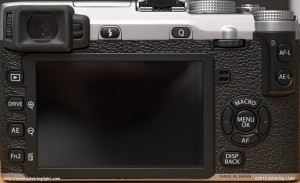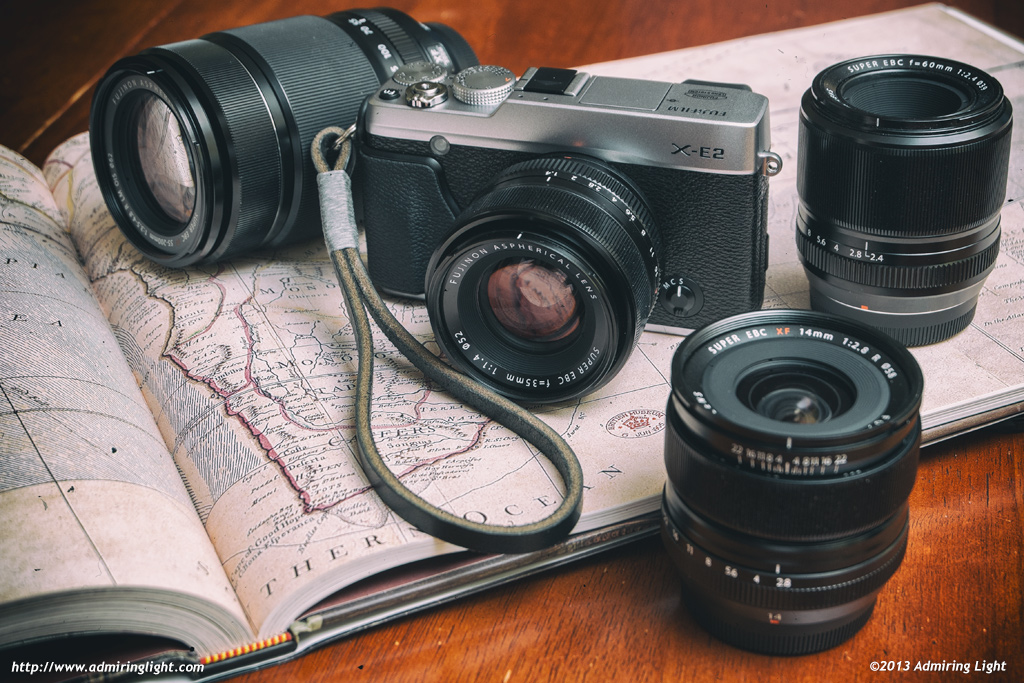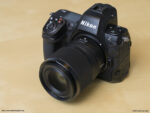Table of Contents
Operation and Menus

Like the other X-Series cameras, the X-E2 features a truly old-school control scheme. There is no mode dial, but rather the aperture is controlled by an aperture ring on the lens, while shutter speed is selected with the dedicated shutter speed dial on the top of the camera. EIther of those two parameters can be set to ‘A’ to make that parameter automatic. There is a dedicated exposure compensation dial that sits at the right rear of the top plate, for easy adjustment by your thumb. The X-E2 has expanded the exposure compensation dial to allow for adjustment +/- 3 full stops in 1/3 stop increments. The shutter speed dial has also seen one minor addition: the camera’s top flash sync speed of 1/180s is now directly selectable.
The simplified old school control scheme is one of the best things about the Fuji X-Series. It allows you to quickly and easily change the major exposure parameters, as well as see what the settings are at a glance, even with the camera off. It’s a wonderful way to operate a camera, and it makes you feel connected to the experience in a tactile way. The X-E2’s dials are a little stiffer than those on the X-E1, which will help prevent accidentally knocking the dial to another setting. Aside from the two dials and the on/off switch and shutter button, a programmable function button, (by default set to control ISO) sits on the top of the camera. In a wonderful usability tweak, long pressing on a programmable button brings you right to the menu option to change the function of that button. Slick.

The only control on the front of the camera is a toggle switch that easily flips between single shot autofocus, continuous autofocus and manual focus. Previous Fuji X cameras required you to be in manual focus in order to magnify the live view. While focus peaking and the digital split-prism focusing (I’ll get into those more later)are only accessible in manual focus mode, you can now magnify the live view in any focus mode by pressing in on the rear dial.
Fuji has tweaked the controls on the rear of the camera a bit. The AF button has moved to the four-way controller and in its place a second programmable function is now available. The Q button has moved to the old location of the View Mode button, which has mysteriously disappeared. The final tweak is the splitting of the AEL/AFL into dedicated buttons for each parameter on the thumb rest hump. The buttons are well laid out and easy to access, and it makes operating the camera simple and straightforward.
Fuji’s menus are also well laid out easy to navigate. The main menu has five shooting sections and three ‘setup’ sections. There is also the easily accessible ‘Q’ menu, which is entered by pressing the Q button on the rear of the camera. This brings up a panel of common settings, including ISO, JPEG settings, self timer, white balance and autofocus settings. Overall, the interface on the X-E2 is all about power and simplicity: All the functions you need for a great shooting experience are right at your hands, without a bunch of extra stuff you’ll never use.
One area of operation that has been improved in the X-E2 is the Auto ISO function. Previous auto ISO implementation on the X-E1 defaulted to the nominal handholding speed of 1/(1.5xfocal length) with native lenses and 1/30 second on adapted lenses. The X-E2 allows you to set a minimum and maximum ISO as well as a minimum shutter speed. I’ve never been an auto ISO person in the past, but after I started using it on the X-E2, I grew to quite enjoy it.
Performance
One of the biggest issues I had with the X-E1 was the relatively slow and deliberate nature of the camera. You had to wait on the camera to finish writing to a card to be able to zoom the viewfinder, card writes were slow, there was some shutter lag and overall, the camera was a pretty low-performance affair.
The X-E2 features a new processor that is roughly twice as fast, and as a result, all the annoying lags that were present in the X-E1 are now gone. The camera reacts quickly, writes quickly, doesn’t cause delays for the shooter while it does another task, allows you to zoom and change focus aids and such on the fly while writing to the buffer; shutter lag is extremely short and the camera simply feels like a responsive machine.
One thing to note is that the X-E2 really hungers for a fast SD card. I had been using a 30MB/s SanDisk Ultra for the first part of my time with the X-E2. Upon taking a burst of RAW photos that filled the buffer, it would take a very long time to flush the buffer – in the neighborhood of 20-30 seconds (I didn’t exactly time it). Upon putting a 90MB/s UHS-1 card in the X-E2, after filling the buffer with RAW shots (which is 8 frames), the camera continued to shoot at around 1 fps as long as I chose to hold the button down, and the buffer completely flushed in about 3-4 seconds. That kind of speed means you can rattle off short bursts with regularity and still have a responsive camera.
Burst mode has been increased to 7 frames per second (with locked focus), though the buffer is a little shallow if you’re shooting RAW. The camera can shoot at a rather slow 3 frames per second while maintaining continuous autofocus. In the X-E1 this was a meaningless distinction, as continuous AF on that camera was abysmal. However, the X-E2 has made considerable strides in that area. Let’s take a look:
Autofocus

Autofocus performance has always been the Achilles heel of the Fujifilm X-Series. Fuji started improving that reputation earlier this year by releasing a major firmware update for existing bodies that did improve autofocus considerably, though it still lagged quite a bit behind the competition. With the X-E2, Fuji has promised a big upgrade in autofocus performance, and for the most part, they’ve succeeded.
The X-E2’s X-Trans CMOS II sensor features phase detection (PDAF) pixels on the sensor, and Fuji has further refined the contrast detection (CDAF) algorithms as well. The result is a vastly improved autofocus system, though not without its quirks.
Phase detection is only available when using the central 9 autofocus points, out of the total grid of 35 points. When using focus points outside this zone, or when the phase detection pixels can’t detect vertical contrast, the camera will use CDAF only. The CDAF improvements have made the X-E2 a competent camera in single shot AF, with relatively decent speed and very good accuracy. There is less hunting back and forth when using CDAF than there was on the X-E1 and speed is relatively quick, though still a little slower than the newer Micro 4/3 cameras. Still, the speed is quite decent.

When using the PDAF points in areas where they can detect vertical contrast (these are not cross-type PDAF sensors), the autofocus is exceptionally fast. In fact, when using the faster focusing lenses, the X-E2 will lock on nearly instantly. You can always tell when PDAF engages because there is absolutely no hunting of the lens. You press the button, and the camera instantly moves to the focus point. I have not noticed any front or backfocus when using PDAF. Accuracy is just as good as with straight CDAF. While you don’t always get the blazing speed with the X-E2 (it will default quickly to CDAF if the PDAF can’t find contrast), overall, the AF is quite good now, and finally on par with many other mirrorless cameras.
As a small usability touch, in addition to the focus square turning green now, there is a small green dot below the exposure compensation indicator in the viewfinder that appears when focus is confirmed. Just another nice touch, especially when shooting in silent mode.
The addition of PDAF on sensor also means that the X-E2 is capable of actually tracking a moving subject. I tested the X-E2 with the Fuji 55-200mm lens and my daughter running right at me at a full sprint. Setting the camera to the low-speed burst mode of 3 fps and tracking her, a surprisingly high number of shots were in perfect focus. There were a few out of focus shot at the beginning of a run, though the camera quickly locked on after that and positively tracked movement until she got very close to me. During that tracking, about 80% of the shots were in perfect focus. While not at the level of most higher grade SLRs, the X-E2’s continuous focus works, and works fairly well.
With more and more cameras from multiple manufacturers having on-sensor phase detection, it seems that the days of inadequate continuous autofocus in mirrorless cameras are coming to a close.






Leave a Reply